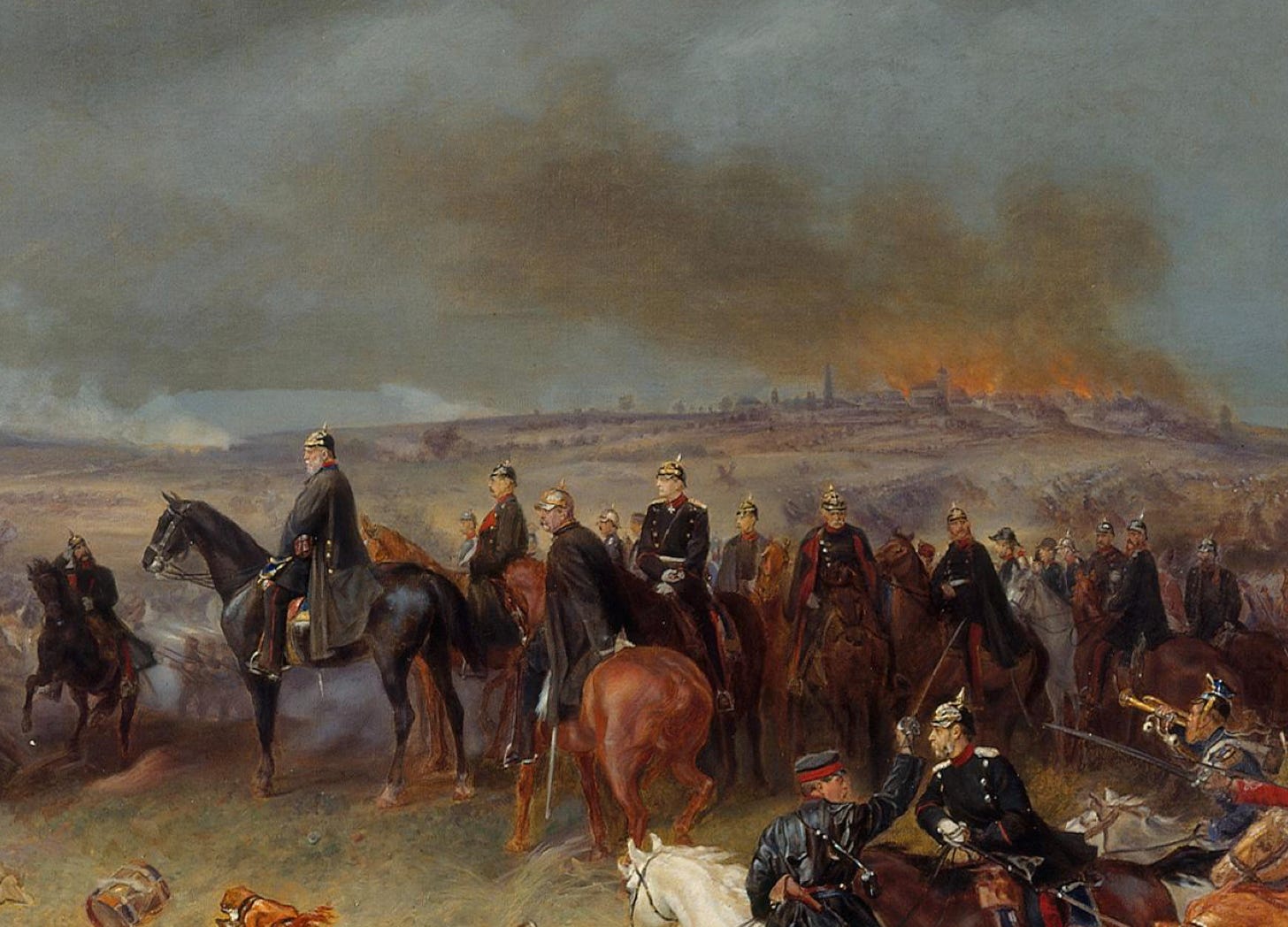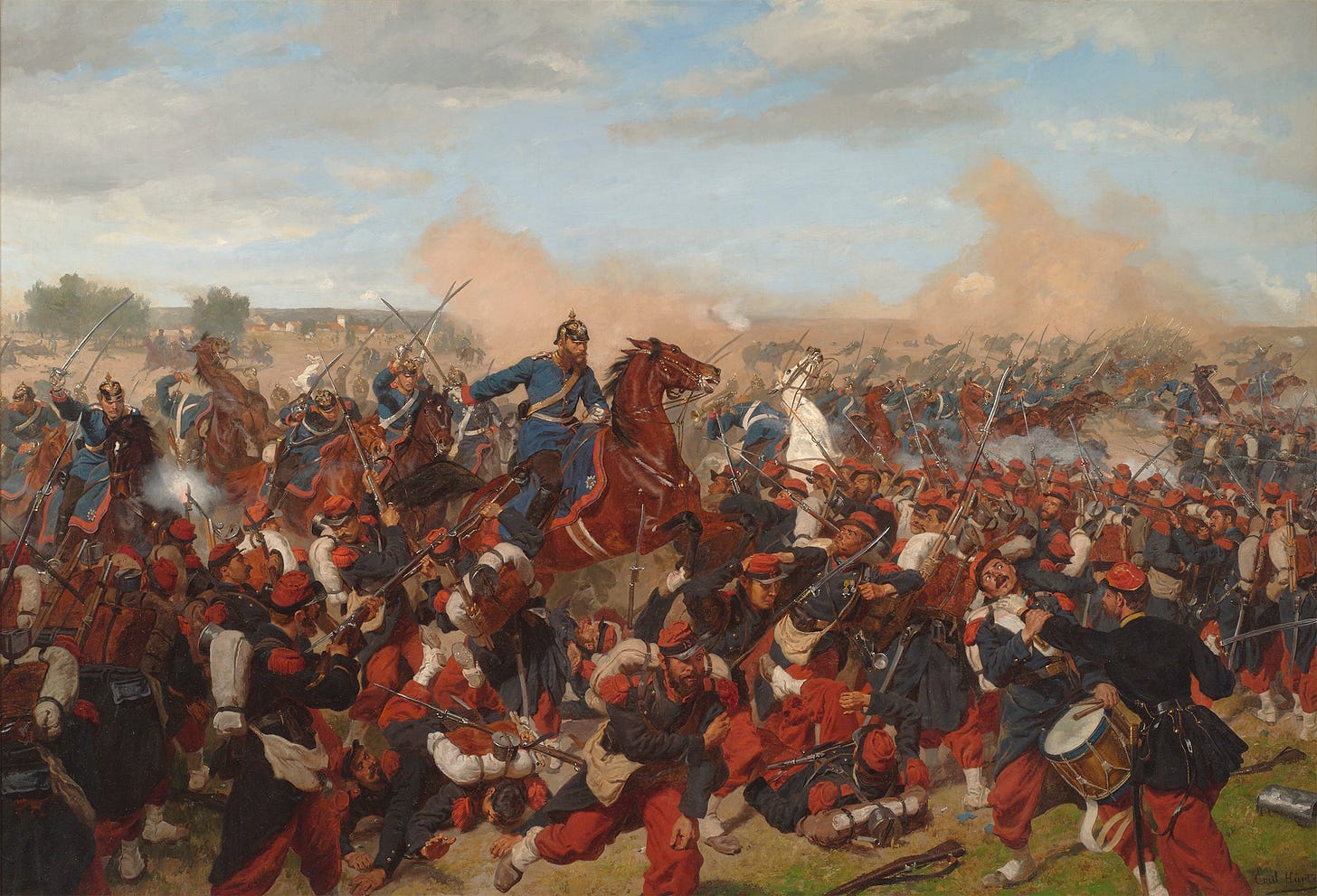Part II, Section A (Moltke, Schlieffen, von der Goltz)
The Modern Military Commander
This post is part of a long series. To read the parts that precede it, and those that follow, please use the following display link.
Field Marshal Count Moltke, Count Schlieffen, and the World War
Georg Wetzell
Foerster writes that 'since the middle of the 19th century the picture showing the general directing the battle from some observation point has been destroyed'. Then again he admits that Moltke, at the side of his King, watched the Battle of Königgrätz, 1866, from Mt. Rozkos and took up similar posts during the battles of Gravelotte and Sedan, 1870. This, he says, was 'a technical error due to a natural concession to the traditional picture of the past but corrected in the meantime'.
Apparently the pace of the 'technical revolution' was not so hasty after all, for it took another 40 years to overcome the deficiency which existed at the time of Moltke.
Yet there certainly must have been reasons other than the 'traditional picture' which caused Field Marshal Moltke to be invariably near the decisive point of the battle, indeed, to conduct the operations by issuing direct orders, as in the Battles of Königgrätz, Gravelotte and Sedan. He knew military history and, especially in 1866, he had gathered ample experiences prior to the Battle of Königgrätz. He realized that 'the operations do not depend solely upon one’s own initiative, but on the independent decisions of the opponent as well' (Moltke); and that 'misapprehensions, erroneous conclusions and failure to take essential steps can have disastrous consequences' (Freytag).
That was the reason why Moltke did not remain far in the rear at a desk, but took up a position far enough forward to enable him to observe matters and personally to take a decisive hand wherever required. All major operations in war are shrouded in secrecy and involve high stakes; nothing can alter that. 'Depending upon the outcome,' writes Freytag-Loringhoven, 'military history puts them down either as examples of greatest wisdom or as mistakes.
'At midnight of July 2, the night before the battle of Königgrätz, Moltke did not know the disposition of the Austrian forces. It was not until he received a personal message from the chief of staff of Prince Frederick Carl that the situation was clear in his mind. Here he chose Napoleon’s means of transmitting orders to the Army of the Crown Prince, the mounted messenger, in preference to the technical facilities which, though available, were still in a state of imperfection. He won the battle; it must be noted, however, that he was compelled to intervene personally on several occasions.
In 1870, some of Moltke’s own army commanders (Steinmetz) were so greatly misinformed of the true situation at the outset of the hostilities that Moltke found it impossible to carry out his original plan of a joint action of the three armies; while the three armies were concentrated side by side, the Second and Third Armies were separated by the Vosges Mountains.
It was the uncertainty regarding the hostile disposition and the situation of the friendly forces on the Metz front which caused Moltke, on August 15, to emulate Napoleon and rush to the battlefield of Colombey; to gain a clear picture of the situation of the Second Army from the high ground of Verneville, on the 17th; and to issue the famous directive for the Battle of Gravelotte — St. Privat, on the 18th: 'Advance by echelons from the left flank'. In this connection, it must be noted that the crisis of Mars-la-Tour, on the 16th, was due to a misconception on the part of the staff of Prince Frederick Charles, despite the very definite instructions issued by Moltke, and was mastered only by the bold action of Constantin von Alvensleben.
During the World War, the Commander of the German First Army [von Klück], in the Battle of Mons, learned at 11:00 PM, August 22 (first day of the Sambre and Meuse operation), that his army was facing the British Expeditionary Force. Not believing this information, he held up the advance of his entire army (except the corps on the left flank) for several hours the following day of the battle upon receipt of other news which meanwhile had become obsolete. As a result, the opportunity of making a large-scale envelopment was blocked. To quote Clausewitz: 'It is the frictions which distinguish strategy in actual war from paper strategy in peace.'
Goltz writes that in many a war even 'the best military commander-in-chief has foundered on his subordinate commanders'. The best example is furnished by the 'war god himself,' Napoleon, and his marshals, of whom he says that 'not one of them was competent to occupy a position of high command. That was my most vulnerable point.' It was indeed Napoleon’s greatest fault, but it was his own.
To be continued …







What is the best military biography of the elder Von Moltke in English?
Ref Question on von Moltke. What of this one? "Blood and Iron: From Bismarck to Hitler the Von Moltke Family's History"